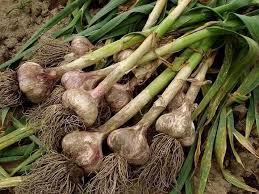
Kenyan local market is currently in need of more farmers or improved production of garlic to curb the over 1,000 tonnes acute shortage of the onions every year that has been forcing the country to opt for imports to fill the deficit.
According to the Horticultural Crops Directorate (HCD), the country produces an estimate of 2,000 metric tonnes of garlic per year. However, this amount is not enough to supply demand in the Kenyan market forcing the country to import about half of the produce.
The latest data released by the directorate revealed that about 50 percent of garlic imports that Kenya requested came from China as traders and suppliers from other countries rallied to help lessen the supply gap.
It is shocking that after packaging and importing all the way from China or even Tanzania, garlic is sold at a wholesale price of about Sh200 per kilo.
This happens at a time experts argue that garlic can grow well in Kenya and does not require much as farmers would have thought and the prices for this commodity have remained at an all-time high.
“Unlike other high-value crops, garlic is not hard to grow because there are a few important requirements that can be easily met.”
Generally, fertile well-drained soil, adequate moisture, and, of course, planting the right seeds (disease-free germinated cloves) is all you need to successfully grow garlic.
In Kenya, garlic can do well in parts of Narok, Nakuru and Meru but mostly the farming has only been done on a small scale.
RELATED ARTICLE: Exporter looking for ginger, garlic, okra, pumpkin for its growing markets
Garlic production
Planting
Garlic is vegetatively propagated. That means that the farmer has to plant individual cloves separated from the main bulb.
It is advisable to plant between 100 and 200kg of cloves on an acre for easy irrigation and weeding. It is also good to plant garlic in double rows or in wide beds of four to six rows with 10 to 20cm between plants.
RELATED ARTICLE: Garlic farming and marketing
Manure application
Garlic does well if well-composted manure is ploughed in before planting. Top dressing with liquid manure should be done regularly at the beginning of 6 - 8 weeks and increased during bulb formation.
Water
Lack of water during growth is the most common stress because garlic does not compensate for drought periods by prolonged growth. Even a short period of drought affects the yield, especially during bulb expansion because lack of water predisposes the crop to infestation by insects.
Possible disease and control
The most common diseases are purple blotch, downey mildew, rust and bulb rot (white rot). They can be controlled through long crop rotation, improved drainage and use of copper based fungicides such as copper oxydchloride, which is accepted in organic farming.
Finally harvesting should start when the lower leaves begin to yellow and fold and the garlic grows “weak at the neck” and begins to fall on the ground.
RELATED ARTICLE: Growing garlic for natural pest control
Possible returns
Assuming it’s small-scale in one piece of an acre, you will require 100 kilograms of garlic seeds which cost roughly Sh390 per kilo. Hence, the cost of production will be 39,000. One acre of land will produce around 4,000 t 5,000 kilograms of the crop.
Assuming you harvest 4,000 kilos and sell them at Sh350 per kilo when in peak season you will make a gross income of about 1,400,000 and minus 39,000, production cost, a farmer can rake 1,361,000 net income.
















Comments powered by CComment